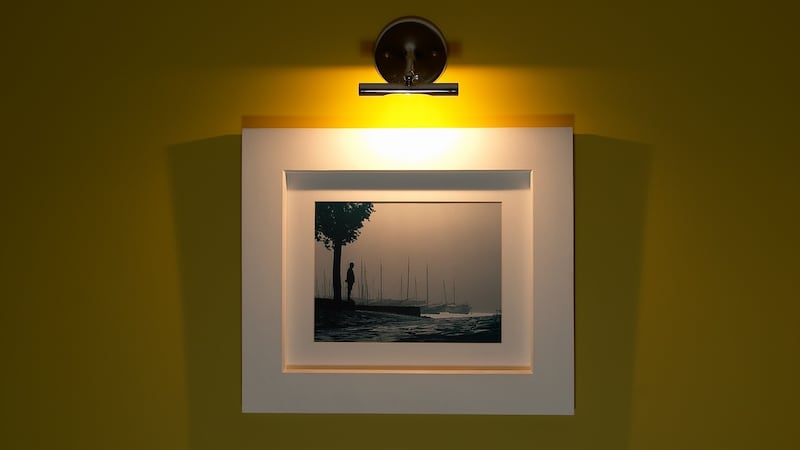Hanging art can sometimes lead to such choice paralysis that walls end up bare for much longer than we’d planned. Drilling holes in walls can make people nervous. They worry about putting it in the wrong place or are confused about how to group pieces together – not to mention how to frame the piece to make it look its best. Angel Denis of Frame Experts advises on how to tackle wall hanging with confidence.
Height matters
When it comes to choosing the perfect height for your pictures, artwork at home is often placed uncomfortably high. Denis recommends keeping the centre of the picture at eye level. The only exception is when you’re hanging over a sofa, mantelpiece or headboard. In these situations, Denis recommends keeping a 10cm gap between the top of the mantelpiece or furniture and the bottom of the frame.
Family photos
Family photos are something many people can have in abundance but they are often unsure about how to display them properly. In some cases, these photos get framed in the brown or black cardboard mount they came in, which really doesn’t do them justice. Think school and graduation photos. The focus tends to be the mount and not the photograph.
This way of framing may also damage your photos. “When photos are not properly mounted they can react to heat and moisture over time which causes them to ripple,” warns Denis. He recommends removing the photographer’s mount and properly mounting the photo before framing. “I’d recommend a very simple mount, paired with a slim 10mm or 15mm frame. When it comes to framing photographs, less is more,” he advises.

The choice of glass for photographs is important, too. “Photos don’t tend to age well because they fade,” says Denis. Choosing anti-reflective glass instead of ordinary glass will protect photos from fading.
“Anti-reflective glass has come a long way in the last 10 years. Museum glass, for example, offers 70 per cent UV protection so it will stop photos and artworks from fading.” This glass is also ideal for displaying photos and art because it is only 10per cent reflective. “The reflection is reduced so much that the glass is almost invisible,” he says. There is also a version that offers 90 per cent UV protection, which is ideal for valuable artworks. Anti-reflective glass is about 30 per cent more expensive than ordinary glass.
Choose the right frame and mount
Your choice of frame, mount and glass should all work together to enhance the artwork. “The frame should never be too heavy, as it can take away from the picture,” says Denis.
It’s a good idea to chat through different options with your framer before committing. This kind of consultation means you know what you are getting, but it is also an opportunity for the framer to find out a little bit about the decor in the room where you plan to hang the artwork. “I always ask questions about the decor. The frame needs to complement the room as well as the image,’ says Denis.
A new frame and mount can give a treasured artwork a whole new lease of life. Trends change over time, and sometimes older-style frames can make an artwork feel dated. “By reframing you can completely transform the piece,” says Denis. “The same apples to the mount. If the mount is the wrong colour it can really detract from the picture.”
Not all pictures need to be glazed. Oil paintings, for example, work beautifully without glass. “For oil on canvas, a floating mount is really popular,” says Denis. This is where the canvas is stretched on a stretcher bar to create a shallow box, which is then mounted over a board and finished with a frame. Oil paintings are typically finished with a clear varnish that offers protection. “If extra protection is required I’d recommend going with anti-reflection glass as opposed to normal glass.”
How to hang
“Hanging pictures properly is really important,” says Denis. “When pictures aren’t hung correctly, not only do they not look well but if the correct fittings haven’t been used, there is a risk they will fall and break.”
He advises against using Velcro products for hanging pictures. “They are ideal for Christmas decorations or light decorative pieces but where glass is involved there’s a risk the picture will fall,” he warns. “For solid walls you should drill a hole and use a wall plug and screw. Make sure the screw goes all the way into the plug until you can’t see the thread. This is so the thread doesn’t damage the string or cause it to wear down and the picture to eventually fall.”
For plasterboard walls there is a special plug that can be fitted with a Phillips head screwdriver. It’s very easy to install and can hold up to 7kg. For larger pictures he recommends using two rather than one of these fittings spaced apart for additional support. For smaller pieces, there are special hooks with three little nails that can be fitted straight to a wall with a hammer.
Denise O’Connor is an architect and design consultant @optimisedesign













